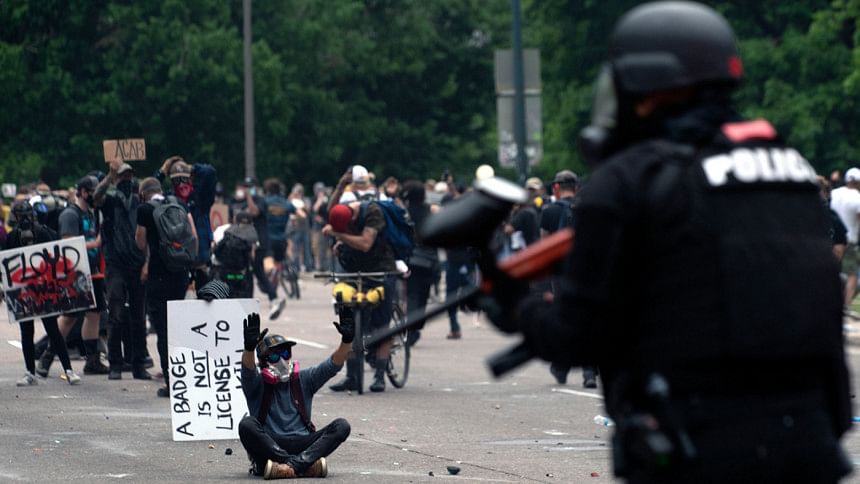Police brutality: Understanding American policing

Police brutality is no strange phenomenon to the American criminal law enforcement scenario. However, the happenings since George Floyd's death in Minneapolis last month have demonstrated unusually deep anger and anguish, and protests continue. The rage and helplessness of the black minority can be gauged from the fact that recently a majority of Minneapolis city council has pledged to dismantle the local police department, a significant move amid nationwide protests sparked by George Floyd's death.
Nine out of the 13 councilors said a "new model of public safety" would be created in a city where law enforcement has been accused of racism. Activists, who for years have demanded such a step, called it a turning point. The nine councilors read a statement which is as follows: "We are here because here in Minneapolis and in cities across the United States it is clear that our existing system of policing and public safety is not keeping our communities safe. Our efforts at incremental reform have failed." One councilor added that the city police department was "not re-formable and that we are going to end the current policing system".
The director of the Minnesota based campaign group Black Vision said: "It should not have taken so much death to get us here. We are safer without armed, unaccountable patrols supported by the State hunting black people". Quite interestingly, the "defund the police" was a rallying cry during the latest street protests. "Defunding" advocates have for years been condemning what they describe as the aggressive militarised policing in the United States. They argue that police department's budget should be slashed and funds diverted to social programmes to avoid unnecessary confrontation and heal the racial divide.
It is curious to note that in the United States, entire city police departments have been disbanded before; in Compton, California, in 2000 and 12 years later in Camden, New Jersey. In both case, they were replaced with bigger new forces that covered local counties.
In order to appreciate the dynamics of policing in America, one has to understand the American political structure and the history of politics in policing therein. The plethora of local police departments coupled with a political system which quite deliberately minimises State or national government control, has some very important consequences for police accountability in the United States. The American constitution is the defining document of the nation's political structure and the founding fathers defined the political structure in such a way that it expressly limits the power of government and implicitly forbids legislation which might contravene any of the provisions of the Constitution.
The power of the United States constitution over legislative changes is exemplified by the issue of gun control. Despite many instances of multiple shootings in schools and workplaces in the United States, any meaningful gun control legislation there would infringe the Constitutional right to bear arms, a right which much of the rest of the world sees as downright dangerous and completely anachronistic. The tenth amendment to the Constitution of the US held that all powers not explicitly reserved to the national government were delegate to the States and citizens, permitting the separate development of individual states. Thus when the establishment of police was considered in mid-19th century, any surrender of control of police to State or national government was to relinquish power from the citizenry to that level of government, and therefore had to be resisted strongly.
There are no national requirements, still less is there is a national inspection system for police in the United States. For good or ill, control of police within the United States rests almost totally with local government. The bulk of police work is done by local police. The resistance to government power implied in the declaration of independence of United States has prevented national or state government having significant control over the major agency for the expression of civil power, the police. In other words, the Constitutional authority for self-determination of American communities enabled policing to be a local responsibility. As a result, less interference was possible with locally approved policing methods, whether or not they complied with State or Constitutional law.
The establishment by communities of their town council, policing and courts without reference to higher levels of government enabled the principles of vigilantism to be legitimised. At certain places in frontier history, the will of the people virtually legitimised vigilante justice. "In the South, the line between vigilante justice and official justice was scarcely discernable at all-at least not until the beginnings of Civil Rights movement of the 1960s and the demise of the segregation laws."
Vigilante justice included lynching, usually of African-Americans, and was condoned by police. Before the Civil Rights movement, however, the voting population was white and the white, male police force was directly answerable only to the white community. Order maintenance, therefore, included steps to allay community fears, which required that "Negroes be kept in their place". One can understand how such unjustifiable form of policing came into being and continued unchecked due to a lack of effective supervision of local police by State or national government agencies.
The reality is that American cities are more violent than elsewhere and police there is generally rougher than the Australian or British counterparts. However, in the creation of this violent and rough climate, the attitude of a racially biased police outfit is no less a contributor. In such circumstances, training has failed to properly orient the white officers and consequently, the dejected black community has been constrained to realise that being black, itself, is an offence. It is no wonder that protestation like "my skin is not a weapon" has appeared quite prominently in recent protests.
It would not be out of place here to refer to professor Joseph Ellis, author of "American Sphinx: The Character of Thomas Jefferson". Writing about the founding fathers, the author credits them with "All those unbelievable acts of imagination. The most creative political group in American history. We will never replicate that…." But poignantly adds that they failed to create a biracial state and that, "Racism is a chromosome in the DNA of the United States. It is like cancer. It ain't never gonna be cured."
Massive reform including change of police attitude is the key. Necessary legislative changes that are in the offing should include demilitarisation of police and greater resource allocation for socio-economic upliftment of the depressed sections. There is a flicker of hope in the fact that the grandchildren of the slave masters have taken active part in the dismantling of the statues of the slave masters.
Muhammad Nurul Huda is a former IGP.

 For all latest news, follow The Daily Star's Google News channel.
For all latest news, follow The Daily Star's Google News channel. 



Comments